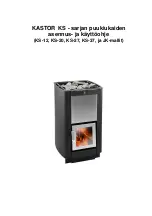
3
1.0 Pre-installation checks & general safety notes
Installation of this stove
must be
completed in accordance with current local codes and
Regulations in each country. All local Regulations & any Rules in Force, including those which
refer to National and European standards,
must be
observed when installing this product.
Reference
must be
made to current issues of British Standard BS 8303, code of practice for
installation of domestic heating and cooking appliances burning solid mineral fuel and BS EN
15287-1:2007 design, Installation, and Commissioning of chimneys.
Note: It is a legal requirement under England & Wales Building Regulations that the installation of
this stove is undertaken under Local Authority Building Control or is installed by a competent
person registered with a Government Approved Competent Persons Scheme. Hetas Ltd operate
such a scheme and a listing of their registered Competent Persons can be found on their website
at www.hetas.co.uk
Should any conflict occur between these instructions and any current Regulations and Rules in
Force then the Regulations and Rules in force must apply.
An approved Carbon Monoxide alarm conforming to the latest edition of BS EN 50291
must be
installed into the room into which the stove is installed. Installation and positioning
must be
in
accordance with current National Building Regulations & any Rules in Force including (Approved
Document J. England & Wales). Also refer to alarm manufacturer's instructions.
This stove
must not
be installed into a flue that shares any other appliance.
Extractions fans or units
must not
be installed into the room of stove installation.
The installer has a responsibility to
ensure
that all requirements of Health & Safety at Work Act
are observed & implemented as stated on the date of installation.
Due to the weight of this stove adequate facilities
must be
available for loading, unloading &
installation.
Always
ensure that there is an adequate air supply into the room containing the stove.
It is very important that flue ways are regularly swept & checked by an approved person. It is
recommended that sweeping and checking should be done at least twice each year for approved
smokeless fuel use and quarterly each year for wood burning. The installer must ensure that the
chimney is examined for soundness and suitability before the appliance is installed. Remedial
action should be taken if required, seeking expert advice if necessary. Where the chimney is
believed to have previously served an open fire installation it is possible that the higher flue gas
temperatures from a closed appliance may loosen deposits that were previously firmly adhered,
with the consequent risk of flue blockage. It is therefore recommended that the chimney be
swept a second time within a month of regular use after installation.
All dampers or restrictors
must be
removed from the flue.
This stove
must be
maintained to ensure safe operation & efficiency.
Only use
this appliance for domestic property heating in accordance with these instructions.
This appliance
is not
suitable and
must not
be installed to any type of water vessel.
Fire cement can be caustic & should
not be allowed
to come into contact with skin. Refer to
manufacturer’s instructions.
This stove contains no asbestos. If there is any situation or possibility of disturbing any asbestos
during installation
seek professional advice
.
An installation / user manual is enclosed with this product. The installation
can only be used
after
it has been inspected by a qualified inspector. A name plate of heat-resistant material is affixed to
this product. This contains information about identification and documentation for the product.
1.2
The Clean Air Act 1993 and Smoke Control Areas
Under the Clean Air Act local authorities may declare the whole or part of the district of the authority
to be a smoke control area. It is an offence to emit smoke from a chimney of a building, from a
furnace or from any fixed boiler if located in a designated smoke control area. It is also an offence to




































